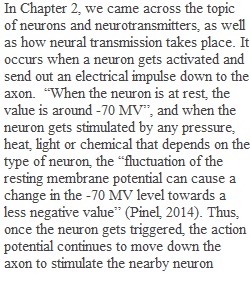


Q For 24 points, after watching the video in the Ch 2 modules about neurons, thoroughly describe how complete neuron transmission works. Then, pick two neurotransmitters and briefly describe them in your OWN words: a) what they do for your body/behavior AND b) how each one is specifically tied to a mental health disorder (either attributing to the disorder or you can discuss how it helps to relieve it or both). You may choose neurotransmitters not mentioned in our textbook as well. You will then comment on at least two other students' posts for 10 more points (5 each). Your other post comments can be answering another students' question or correcting a classmate's incorrect responses or sharing an experience that is relevant to the material and linking it to their post. Therefore, each post responding to your classmates should be a couple of paragraphs long. You may also choose to comment on 4 fellow student responses (one paragraph each). You must be very thorough in both sections for full credit! Don't forget, you will use a source (such as the textbook or journal article) so you MUST cite your source and list as a reference, even when you paraphrase! You must use quotations marks for direct quotes (copying any words/phrases) as well as reference your source. If you don't do these things, it is plagiarism, and you won't receive credit. Please watch the power point on plagiarism again if you have questions. This is very important!
View Related Questions